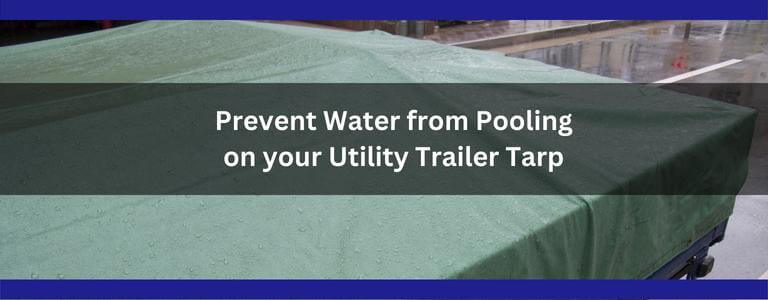
How to Prevent Water from Pooling on your Utility Trailer Tarp
If you have a utility trailer that is open to the air, a tarp is a good accessory to have. You can cover cargo with a tarp while the trailer is in transit to either hold it in place or protect it from the elements. You can also cover your trailer with a tarp to protect it from dust, water, leaves, and other potentially damaging elements when it is not in use.
Ideally, if you plan to store a utility or landscape trailer for long periods of time, you should place it indoors where it is not exposed to rain or cold temperatures. Storing your trailer inside means that you do not have to worry about water pooling on your tarp. However, if you have to store the trailer outside, there are things you can do to prevent water pooling on the tarp.
Why Is It Bad if Water Pools on the Tarp?
A tarp may prevent the inside of the trailer from getting wet, but because of the weight of the water, a tarp over the top of an open trailer will inevitably sink down and trap the water inside. This may not be a problem if you intend to use the trailer the next day, but if the trailer is in storage for a while, the combined weight of the water and the tarp could put stress on trailer fasteners and grommets, possibly loosening them.
A puddle of water, even a relatively shallow one, can provide a breeding ground for microorganisms. As they proliferate, they may make your tarp dirty and slimy. If it is summer, a pool of stagnant water in your trailer could attract mosquitoes to your property looking for a place to lay their eggs. If it is winter, the water could freeze. The ice could be difficult or impossible to remove until it melts again, and in the meantime, the expansion of the frozen water could undermine your trailer’s structural integrity.
What Can You Do To Prevent Water From Pooling on the Tarp?
Merely tightening the tarp won’t be enough to prevent the water from pooling. You probably don’t want to leave cargo in the trailer at all times to raise the tarp up. Fortunately, there are other things you can do to either prevent pooling or deal with it more effectively when it does happen.
You could build some sort of framework out of inexpensive lumber to put inside the trailer when it is not in use to hold the tarp up so that the water runs down the sides. This makes the tarp look and function something like a tent. You could also put curved bows across the top of the trailer so that the tarp could be stretched taut over top of them and the water would run off from the curved sides. You could use PVC piping, copper piping, thin wooden slats, or metal to make the bows. Depending on what you need to haul, these could be either permanent or removable.
You could put a hard cover made of metal or plywood over the top of the trailer and put the tarp on top of that. The hard surface would prevent the tarp from sinking down with the weight of the water. It wouldn’t stop pooling completely, but the pools would be too shallow to do any significant harm.
While you don’t want to leave precious cargo in the trailer under the tarp to keep water from pooling, you could purchase an object that you don’t care about that you could keep in the trailer when you are not using it to hold up the tarp and allow water to run off. A 32-gallon outdoor trash can works well for this.
Millroad Manufacturing produces custom landscape trailers and utility trailers. Work with one of our dealership partners to order a trailer to your specifications.